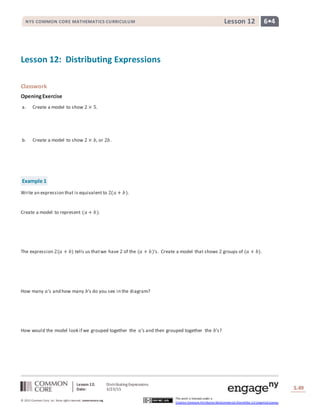
G6 m4-d-lesson 12-s
- 1. Lesson 12: Distributing Expressions Date: 3/23/15 S.49 49 © 2013 Common Core, Inc. Some rightsreserved. commoncore.org This work is licensed under a Creative Commons Attribution-NonCommercial-ShareAlike 3.0 Unported License. NYS COMMON CORE MATHEMATICS CURRICULUM 6•4Lesson 12 Lesson 12: Distributing Expressions Classwork OpeningExercise a. Create a model to show 2 × 5. b. Create a model to show 2 × 𝑏, or 2𝑏. Example 1 Write an expression that is equivalent to 2(𝑎 + 𝑏). Create a model to represent (𝑎 + 𝑏). The expression 2(𝑎 + 𝑏) tells us thatwe have 2 of the (𝑎 + 𝑏)’s. Create a model that shows 2 groups of (𝑎 + 𝑏). How many 𝑎’s and how many 𝑏’s do you see in the diagram? How would the model look if we grouped together the 𝑎’s and then grouped together the 𝑏’s?
- 2. Lesson 12: Distributing Expressions Date: 3/23/15 S.50 50 © 2013 Common Core, Inc. Some rightsreserved. commoncore.org This work is licensed under a Creative Commons Attribution-NonCommercial-ShareAlike 3.0 Unported License. NYS COMMON CORE MATHEMATICS CURRICULUM 6•4Lesson 12 What expression could we write to represent the new diagram? What conclusion can we drawfrom the models aboutequivalent expressions? Let 𝑎 = 3 and 𝑏 = 4. What happens when we double (𝑎 + 𝑏)? Example 2 Write an expression that is equivalentto double (3𝑥 + 4𝑦). How can we rewrite double (3𝑥 + 4𝑦)? Is this expression in factored form, expanded form, or neither? Let’s startthis problem the same way that we started the firstexample. What should we do?
- 3. Lesson 12: Distributing Expressions Date: 3/23/15 S.51 51 © 2013 Common Core, Inc. Some rightsreserved. commoncore.org This work is licensed under a Creative Commons Attribution-NonCommercial-ShareAlike 3.0 Unported License. NYS COMMON CORE MATHEMATICS CURRICULUM 6•4Lesson 12 How can we change the model to show 2(3𝑥 + 4𝑦)? Are there terms that we can combine in this example? What is an equivalentexpression thatwe can use to represent 2(3𝑥 + 4𝑦)? Summarize how you would solvethis question without the model. Example 3 Write an expression in expanded form that is equivalentto the model below. What factored expression is represented in the model? How can we rewrite this expression? 4𝑥 + 5 𝑦
- 4. Lesson 12: Distributing Expressions Date: 3/23/15 S.52 52 © 2013 Common Core, Inc. Some rightsreserved. commoncore.org This work is licensed under a Creative Commons Attribution-NonCommercial-ShareAlike 3.0 Unported License. NYS COMMON CORE MATHEMATICS CURRICULUM 6•4Lesson 12 Example 4 Write an expression that is equivalentto 3(7𝑑 + 4𝑒). Exercises Create a model for each expression below. Then write another equivalentexpression usingthe distributiveproperty. 1. 3(𝑥 + 𝑦) 2. 4(2ℎ + 𝑔)
- 5. Lesson 12: Distributing Expressions Date: 3/23/15 S.53 53 © 2013 Common Core, Inc. Some rightsreserved. commoncore.org This work is licensed under a Creative Commons Attribution-NonCommercial-ShareAlike 3.0 Unported License. NYS COMMON CORE MATHEMATICS CURRICULUM 6•4Lesson 12 Apply the distributiveproperty to write an equivalent expression. 3. 8(ℎ + 3) 4. 3(2ℎ + 7) 5. 5(3𝑥 + 9𝑦) 6. 4(11ℎ + 3𝑔) 7. 8. 𝑎(9𝑏 + 13)
- 6. Lesson 12: Distributing Expressions Date: 3/23/15 S.54 54 © 2013 Common Core, Inc. Some rightsreserved. commoncore.org This work is licensed under a Creative Commons Attribution-NonCommercial-ShareAlike 3.0 Unported License. NYS COMMON CORE MATHEMATICS CURRICULUM 6•4Lesson 12 Problem Set 1. Use the distributiveproperty to expand the followingexpressions. a. 4(𝑥 + 𝑦) b. 8(𝑎 + 3𝑏) c. 3(2𝑥 + 11𝑦) d. 9(7𝑎 + 6𝑏) e. 𝑐(3𝑎 + 𝑏) f. 𝑦(2𝑥 + 11𝑧) 2. Create a model to show that 2(2𝑥 + 3𝑦) = 4𝑥 + 6𝑦.